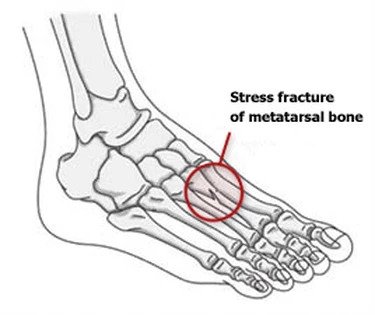A stress fracture is a series of microscopic fissures or severe bruising within the bone. It causes localised pain at the fracture site which may increase during exercise and subside during rest periods. Other symptoms may include swelling, tenderness to touch and visible bruising.

In healthy adults, stress fractures usually result from repeated strenuous activity such as running, jumping and ballet. The most common bones to be affected by stress fractures are the weight bearing lower leg and foot bones e.g. Tibia, Fibula, Calcaneus, Metatarsals, Navicular.
Stress fractures are more likely if there is a recent increase in training levels or the start of a new activity as the body cannot adapt to the increased stress levels. A change in workout surface can also have an effect. Stress fractures can also occur in clients with osteoporosis due to their weakened bone structure. They are more common in female athletes. Stress fractures often do not show up under x-rays and an MRI or bone scan is needed to diagnose them.
Treatment requires avoidance of the activity involved and the fracture usually heals within six to eight weeks of resting. Ice can keep the swelling down as can compression and elevation. A support boot may be necessary to reduce stress on the foot or leg as you go about your normal life.
Return to sport after healing should be gradual to enable the repaired bone to adapt to the increasing load. Prevention of future stress fractures will involve building bone strength with a healthy diet along with muscle strengthening and gradual load bearing so that the body can adapt and be able to absorb the stresses placed upon it.
If you would like any help with dealing with a minor sports injury, please get in touch.

